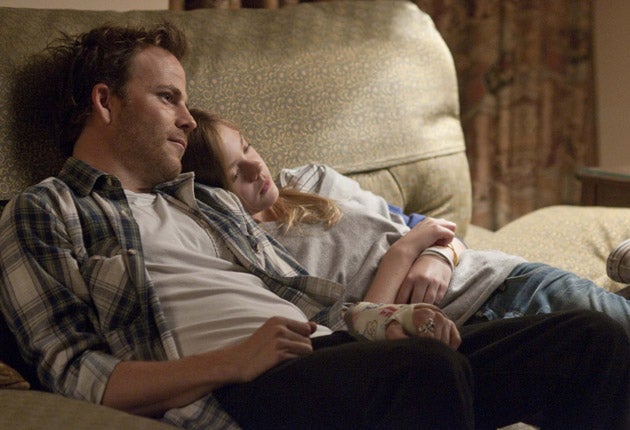Somewhere, Sofia Coppola, 97 mins (15)
Sofia Coppola returns to themes of rootless celebrity in a film so good that, in future, she can ditch those bored actors and move on to something new

As a scion of Hollywood royalty, it's hardly surprising that Sofia Coppola specialises in The View From The VIP Lounge.
Her last film, the lavishly eccentric Marie Antoinette, seemed to present pre-Revolution Versailles as a metaphor for Beverly Hills, and now the follow-up, Somewhere, comes across as a variation on 2003's Lost in Translation, which also depicted the Lifestyles of the Rich, Famous and Chronically Bored. That film was about a Hollywood actor at a loose end while making an advert in Tokyo, having his spirits raised by an encounter with a lively young woman. Somewhere is about a Hollywood actor at a loose end while doing not very much in LA, and having his spirits raised by an encounter with a lively young girl – in this case, his 11-year-old daughter.
The actor is Johnny Marco (Stephen Dorff), a movie star who seems to be permanently between movies, and between actual events in his life. We never see him acting, only promoting past films, or preparing for the next. Work consists of attending a press conference where he gives monosyllabic answers to asinine questions, or grinning through a photo call with a co-star (Michelle Monaghan) who hates his guts. In one scene, he gets fitted for a special-effects latex mask: he sits motionless, his head encased in white glop, only the sound of breath through nostril holes telling us that he's still there. The next shot provides a terrific moment of truth, as the previously young, handsome Johnny stares in the mirror at the wizened rubber face of his aged self: this is the hitherto unknown existential side of prosthetic FX make-up.
Languishing with his arm in plaster after a fall, Johnny lives a life of dissolute bachelor luxury at the Chateau Marmont hotel. It's hardly home: in one scene, Johnny walks into his suite to find a party in full swing, a roomful of strangers barely aware of his presence. But sex is always on tap – a stream of sullen beauties continuously parades in and out of the room across the corridor. Early in the film, Johnny lies on his bed while identical twin pole-dancers go through their moves in perfect sync, living Warhol multiples. He falls asleep in mid-show, and the sisters fold up their poles and leave. It's a terrifically funny scene, in a cruel, caustic way, treated with cool art-cinema detachment, the static camera fixing at length on the girls' coy, strenuous calisthenics. Coppola seems to overdo the joke by having the pair return soon afterwards, but the repetition is part of the point, with a twist. The second time, the twins apparently stay the night; next morning, blonde hair brushes over Johnny as a female hand draws a heart on his plaster cast. But they turn out to belong to Johnny's young daughter Cleo (Elle Fanning), who's come to visit.
Johnny and Cleo spend more time together than expected, when her mother decides to spend some time alone. Johnny ends up taking the kid to Italy, where – echoes of Lost in Translation and its lampooning of the Japanese media – the film takes a turn into broad showbiz farce, with Johnny surrounded by dancing girls at a manically glitzy awards ceremony.
The film is languidly episodic, in no rush to congeal into story. Johnny and Cleo play Guitar Hero and hang out with Johnny's moderately sleazy sidekick (Chris Pontius); Cleo makes eggs Benedict. The pair's quality time ends with an idyllic swimming moment: they pretend to drink tea underwater, then sunbathe on the poolside. The camera pulls slowly back from this still scene: utter happiness, but of a kind that we know will prove ephemeral.
This is a realistic, honest film. Coppola doesn't reassure us that all will now be well between Johnny and Cleo: who knows whether he'll be around much for her in future? Coppola just gives us their window of heightened intimacy, and leaves us to make our own predictions.
A downbeat anti-mainstream aesthetic is established by cameraman Harris Savides in the opening shot, in which Johnny drives his car round in circles, in the middle of nowhere; artfully framed, it could almost be an installation video. Somewhere is, in fact, very much an art film – detached, keenly ironic and free of fake emotional rewards. Stephen Dorff is quietly compelling, giving Johnny the unravelling self-assurance of a man coming to realise that he's turning into Jack Nicholson before his time. As Cleo, Fanning gives a terrific, affecting performance – neither brattishly knowing nor gauchely cute, but alert, relaxed, suggesting an insightful, tolerant child not yet spoilt by what she's learning about the world. In Italy, Cleo finds herself having breakfast with one of Johnny's passing-through girlfriends – and Fanning's quizzically disapproving silent glances provide one of the film's more emotionally eloquent touches.
You'd think it would be hard to elicit sympathy for the inhabitants of the film's mundanely opulent world, but Coppola's restraint and amused compassion make this a film about recognisably fallible people, much more so than movies about Hollywood usually contrive to show us. That said, Coppola probably should find some new subjects other than the pressures of life in privileged snow-globe worlds, but if this subtle, intelligent film is her last word on the subject, it feels like a definitive one.
Next Week:
Jonathan Romney ponders the mysteries of online identity in real-life internet drama Catfish
Join our commenting forum
Join thought-provoking conversations, follow other Independent readers and see their replies
Comments